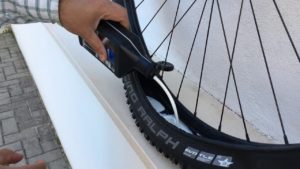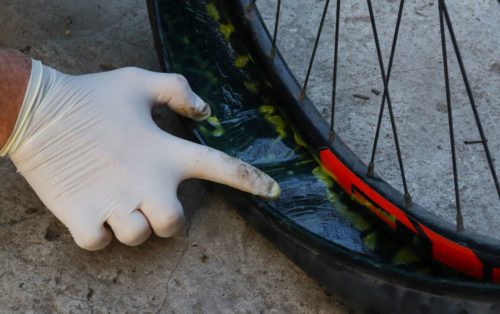Most bike riders now have heard of tubeless tires. They have grown in popularity over the years, and certain bikes rely on them more than others. It’s common for people to wonder if tubeless tires work well on gravel bikes or not.
We understand many people looking around for a bike might very well be shopping for their first gravel bike ever.
Is it worth going tubeless right from the beginning? Like a lot of other bikes, there are many benefits to tubeless tire riding. Each individual will be different as far as whether it is worth it or not.
The Tire Sealant I Use (Amazon)
Tubeless Presta Valve Stem (Amazon)
NoTubes 25-Millimeter Rim Tape for Rim Interior (Amazon)
What Are Tubeless Tires?
As simple as a tubeless tire might seem on paper, there is something to be said for understanding how this specific type of technology works.
Many people out there have only used a tube inside of a tire throughout their life, and switching to something different can seem a little bit intimidating.
From the outside, tubeless tires look no different from one with a tube. The only difference is that there is no inner tube needed, as the tubeless tire provides a seal with the rim.
The only thing left is a valve just like the one that would be found with an inner tube, but it is connected to put air directly into the tire.
The risky part is that neither the rim nor the tire can leak any type of air for the setup to work. That means getting the perfect fit for a tire is essential. If anything is compromised at all, a sealant can help to close everything back up.
Why It’s Worth Going With Tubeless Tires On a Gravel Bike?

There are a few pros that stand out to any gravel bike rider using tubeless tires. Now that people have pretty good feedback on how they perform, this could be a decision worth making for a lot of shoppers out there.
Eliminating Pinch Flats
There’s nothing more annoying when riding a bike than getting a pinch flat seemingly out of nowhere. This occurs when a tire hits some type of obstacle on the trail and deforms the tire just enough that it squashes the inner tube against the rim.
What result is a puncture that is nicknamed a “snake bite,” and it instantly ruins a perfectly good ride.
The reason why pinch flats are eliminated completely with a tubeless tire setup is that there is no inner tube to get in the way.
This comes in handy with bumpier terrains more than smooth rides, but pinch flats sometimes happen on completely flat pavement as well.
Lower Tire Pressure
Lower tire pressure can be very beneficial on uneven terrain. A lot of mountain bike riders love the fact that they can go with much lower tire pressure on their tires with a tubeless setup.
People can say the same thing for gravel bike riding, and that can make a difference when riding comfortably.
A tire that is filled up with a ton of pressure is not going to provide much cushioning at all whenever going over rough surfaces.
Not only that, but it becomes somewhat like a balloon, and that means it runs the risk of popping.
Without a tube getting in the way, lower tire pressure really helps out for those toughest rides. It’s not going to necessarily speed up a person’s ride, but most are going to sacrifice a little bit of speed if they are not rocking around all the time.
Lighter Ride

Believe it or not, it actually makes a difference in weight when going with a tubeless tire setup instead of traditional tubes.
That weight will probably not make or break the average rider, but it can help to share the weight just a little bit.
Anyone looking for a minimalist type of feel to their bike will greatly benefit from something like this.
With lower weight means a chance to have lower rolling resistance. That can help offset the tires being a little lower in pressure, as people can pick up speed faster than they initially imagined.
It’s nice to have a little bit of both worlds, as the low pressure provides comfort, and the low rolling resistance helps with speed.
Better Overall Handling
Going on an off-road adventure can be a lot of fun, until the person feels like they are no longer in control. That type of feeling is something nobody wants to experience, but it happens occasionally. One way to have better handling of a bike overall is to go with tubeless tires.
A lot of the reason why a bike is easier to handle with tubeless tires comes down to some of the benefits already talked about.
Lower tire pressure makes it a little bit easier to brake smoothly. There’s always a chance of a lock up, but an overinflated tire is going to have a harder time absorbing those sudden brake movements compared to one that is at a lower tire pressure.
The truth is, no one is going to find their sweet spot with a gravel bike right from the beginning. It will take a little bit of time to mess around the tire pressure and see what works best.
However, having the ability to move up and down with tire pressure just a bit will help with the overall handling of the bike.
This is great for beginners, but even experienced riders will not feel any information whatsoever when they are going on tougher terrain than usual.
Cons For Tubeless Tires On A Gravel Bike?

It would not be fair to point out that some cons keep people from going tubeless on a gravel bike. While there can be some nitpicking here and there, there are two distinct reasons why some are hesitant to make the jump.
Added Expense
Tubeless tires do tend to run a little bit more expensive than traditional tires. They are considered the modern style, and they are the tires in demand right now.
If there is any good news, less maintenance overall and being able to last longer means that they could be a solid investment in the long run.
However, spending extra money on tubeless tires after buying a brand new bike can seem like a lot of nickel-and-diming for the average consumer.
One way to get around this is to shop for gravel bikes that are already tubeless-ready. This will likely be the best way to go, since most will sample tubeless tire setups at least once before making a decision on their own.
Installation Complications
One would think that without an inner tube, there might be an easier set up process for tubeless tires. Unfortunately, the opposite is true, as they are just a little bit more difficult in general.
It really comes down to making sure that everything is sealed as tightly as possible. There is no wiggle room, and being proficient with sealant is going to be the best way to go.
If a person doesn’t feel like they can pull it off on their own, it might be better to go to a professional to get the tires installed.
This will be another expense, but it’s better to get it right in the first place instead of trying to hope for the best and figure out something is wrong in the middle of a ride.
Final verdict: Are Tubeless Tires The Way To Go With Gravel Bikes?
The simplest answer is that if the plan is to do any type of off-road biking, tubeless tires are the way to go. This can apply to any type of bike, but it’s especially true for gravel options.
The only people who won’t benefit from tubeless tires on the gravel bike are those who plan on just using it as a commuter. Since it will only be on flat ground, the benefits might not be worth it for the added expense.
For everyone else, there is something very relaxing and fun about going out on the open road and exploring off-road as well.
Taking chances on some tame terrain can be so much easier without having to constantly worry about flat tires. That extra bit of lower tire pressure also makes it a more comfortable ride in general.
If possible, shop for a gravel bike that is tubeless-ready if that’s the way a person wants to go. Having versatility with any type of bike setup is very beneficial for all types of riders. The more that can be customized, the better feel a person has for riding overall.

